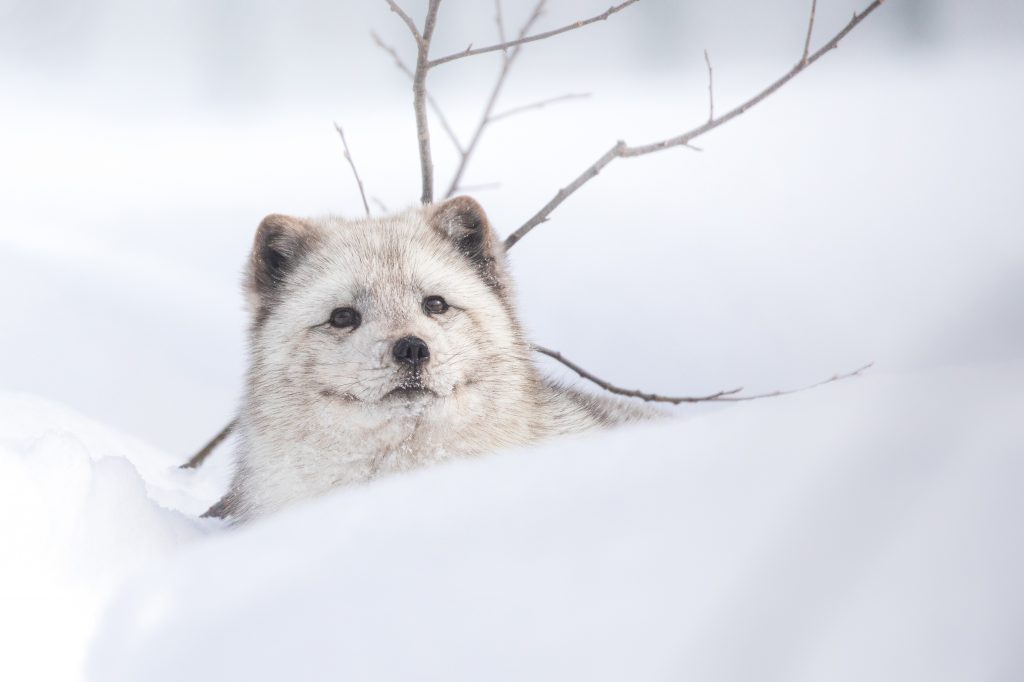Aspen Valley Wildlife Sanctuary in Rosseau provides a special seasonal report about how their residents prepare for the winter months. This article comes from the fall/winter edition of the Aspen Valley Guardian.
There are many ways in which wildlife prepares itself for the cold winter months. Some species, such as groundhogs and bears, commit themselves to varying degrees of hibernation. Birds migrate, while wolves, foxes, and moose use various forms of physical adaptation to make it through the cold winter days.
Interestingly, while bears do prepare themselves for a long winter nap, they are not true
hibernators. Rather, bears enter into a “light” hibernation known as “torpor”, where heart and breathing rates decrease, body temperature reduces slightly, and they don’t eat or release bodily waste. After settling into their dens, bears will sleep for an extended period of time, yet can be aroused by noise or warmer temperatures. Bears may even be seen out and about during this period of time. Bear cubs are born in the den in late January or February, while their mothers are in hibernation. Cubs then remain with their mom in the den until springtime. With a litter of one to four cubs, literally underfoot, the time of rest is truly “light”.
Chipmunks are also “light” hibernators. These gatherers collect and cache (store) their food in underground dens. There, they settle into a self-imposed lock-down, waking every few days to feed on their caches of stored food. Once the stashes have been exhausted, they are believed to more fully hibernate.
On the flip side, groundhogs are one of Canada’s largest “true” hibernators. When a groundhog is down for the winter, it is almost impossible to wake up. While asleep, a groundhog relies on its accumulated body fat to survive; coupled with a drop in body temperature and an astounding drop in heart rate from 80 to only 4 or 5 beats/minute. In this reduced state of activity, energy is conserved during the long, cold winter months when little food is available.
Regardless of the type of hibernation, it has little to do with change in temperature. Rather, it is a survival tactic used by animals to weather a scarcity of food. Essentially, wildlife prepares for the winter months by increasing body fat and supplies. After that, they slow themselves down to conserve energy.
Furley (one of our four bears in residence at the Sanctuary), for example, did not hibernate
before making her forever home here at Aspen Valley Wildlife Sanctuary (AVWS). Furley lived in a small, cement enclosure situated within a Provincial Park until it was closed down in 2013. There, Furley was fed throughout the winter months, which negated her natural instinct to hibernate. This was done in the name of year-round public viewing – something we are opposed to here at the Sanctuary.
At Aspen Valley, Furley has a large enclosure with her own pond in a cool, shady forest. Here, we begin to supplement her food consumption in the fall, but stop feeding her in November – at which point she takes the cue and goes into a “light” hibernation (as though she was living in the wild).
AVWS is also home to a number of species that do not hibernate. Rather, they adapt to the cold.
Our Arctic fox, Mystic, is a sub-zero specialist who adapts well to the winter months. Her
compact body, short legs, and small ears help to conserve heat, while her large, furry paws allow her to walk on top of snowdrifts. Able to withstand Muskoka’s coldest temperatures, Mystic will often be seen sheltered in her enclosure, with her long, bushy tail wrapped around her head like a scarf. Mystic’s coat also changes colour from grey to white. This adaptation allows the Artic fox to blend into winter’s white canvas and evade predators.
Wolves are largely carnivorous, and by targeting small to medium-sized prey in the wild, they do quite well for themselves during the winter months. This is the time when sick, injured, and weak prey are more vulnerable. It’s the good news / bad news circle of life. Wolves also rely on heavy feeding in the fall and thick coats, which keep them warm on the coldest winter nights.
Then there’s our beloved moose, Ella. In the wild, her contemporaries store up large quantities of fat for their bodies to utilize throughout the winter months. Another adaptation is the extensive thickening of their coats, which can pose a problem when faced with a mild winter. Heat stress and tick infestations are common in moose when lakes are frozen and there is nowhere to cool off.
To learn more about the animals at Aspen Valley Wildlife Sanctuary, visit their website.
